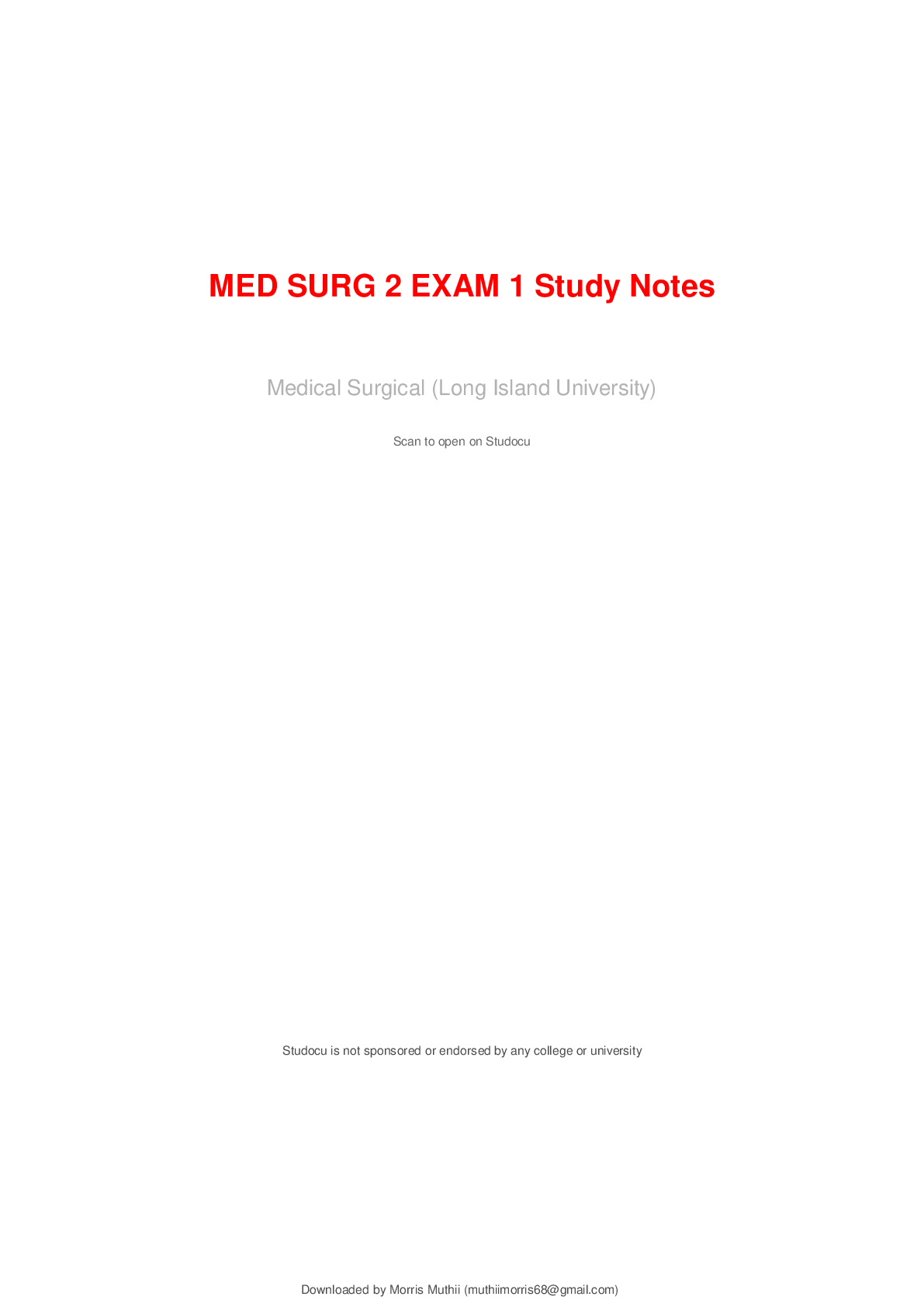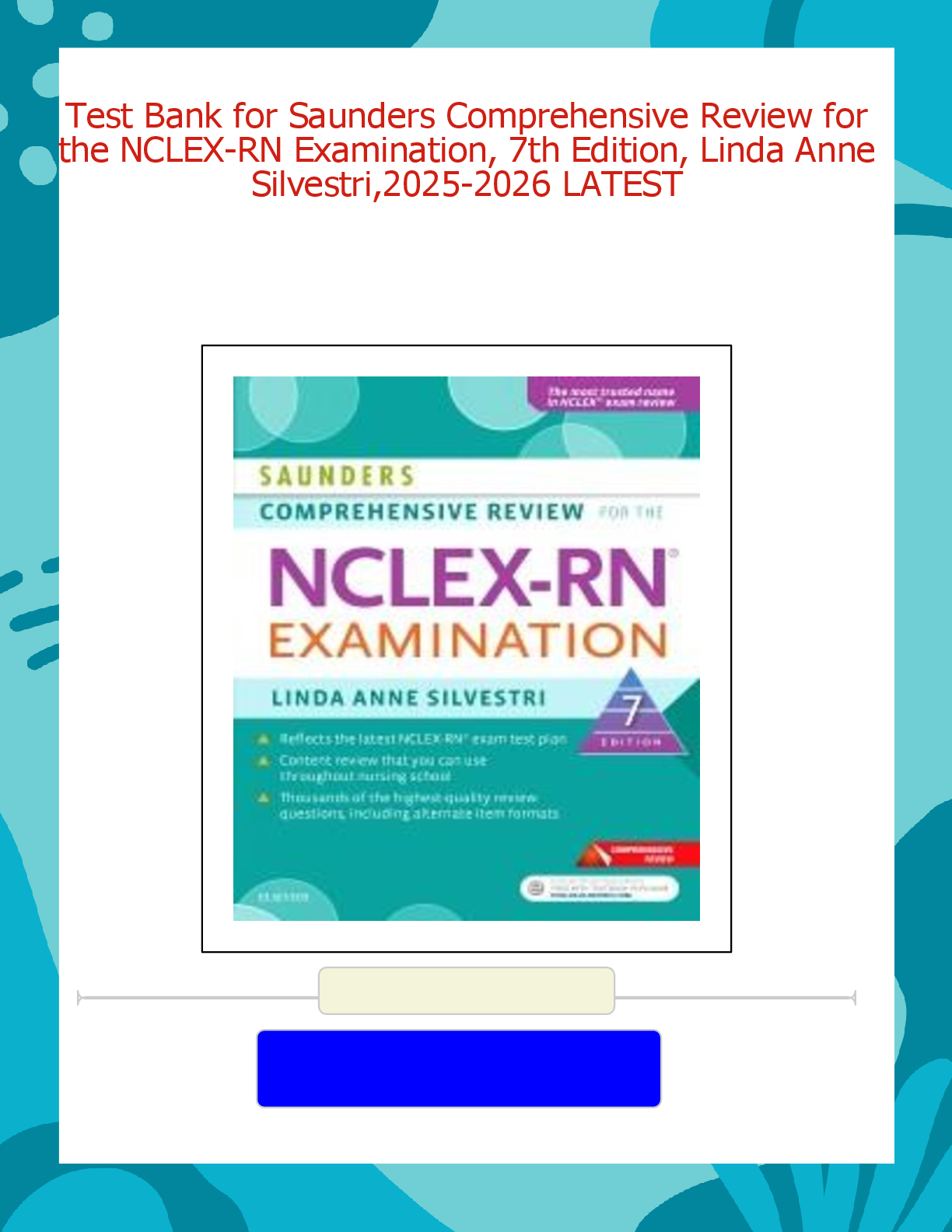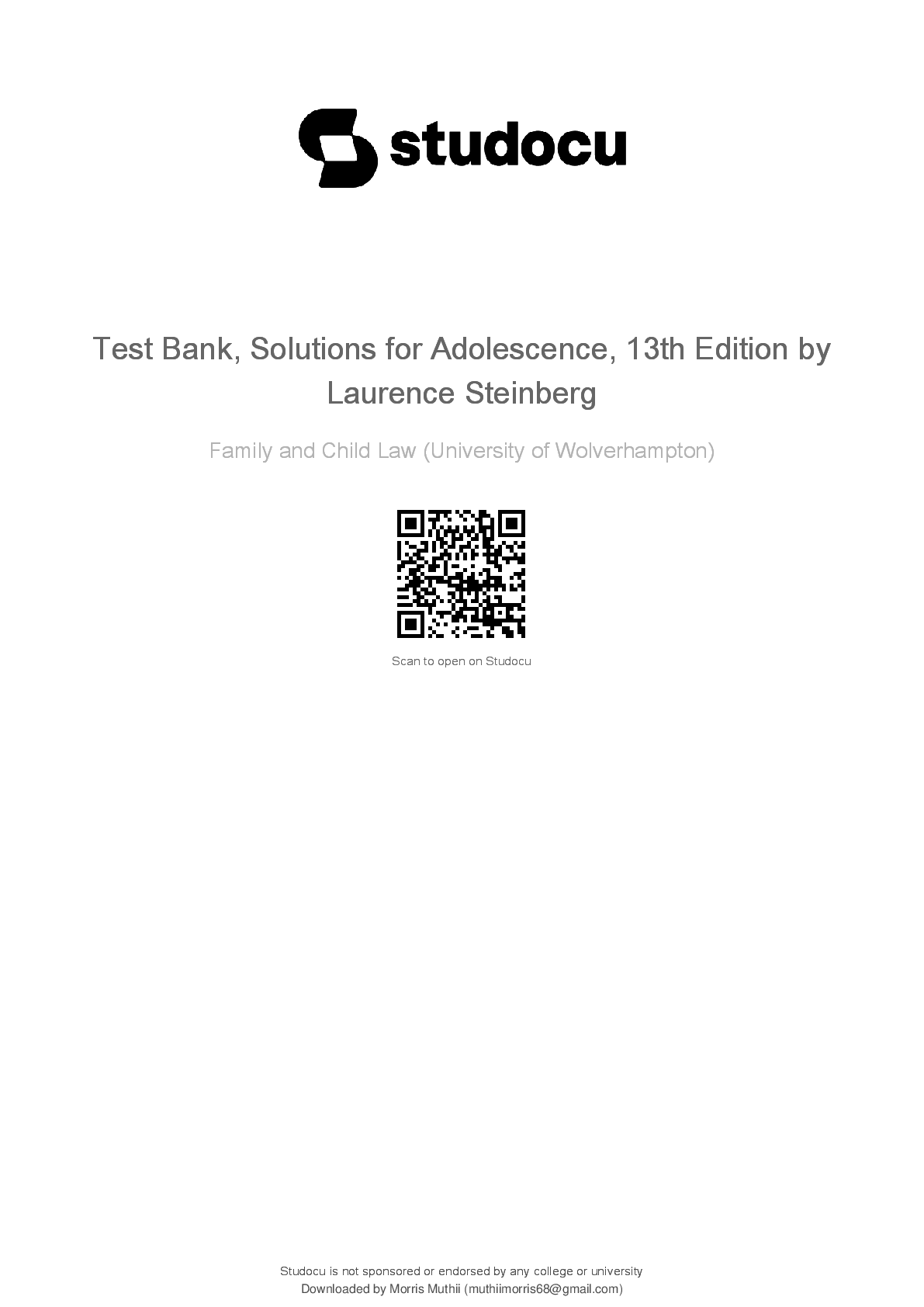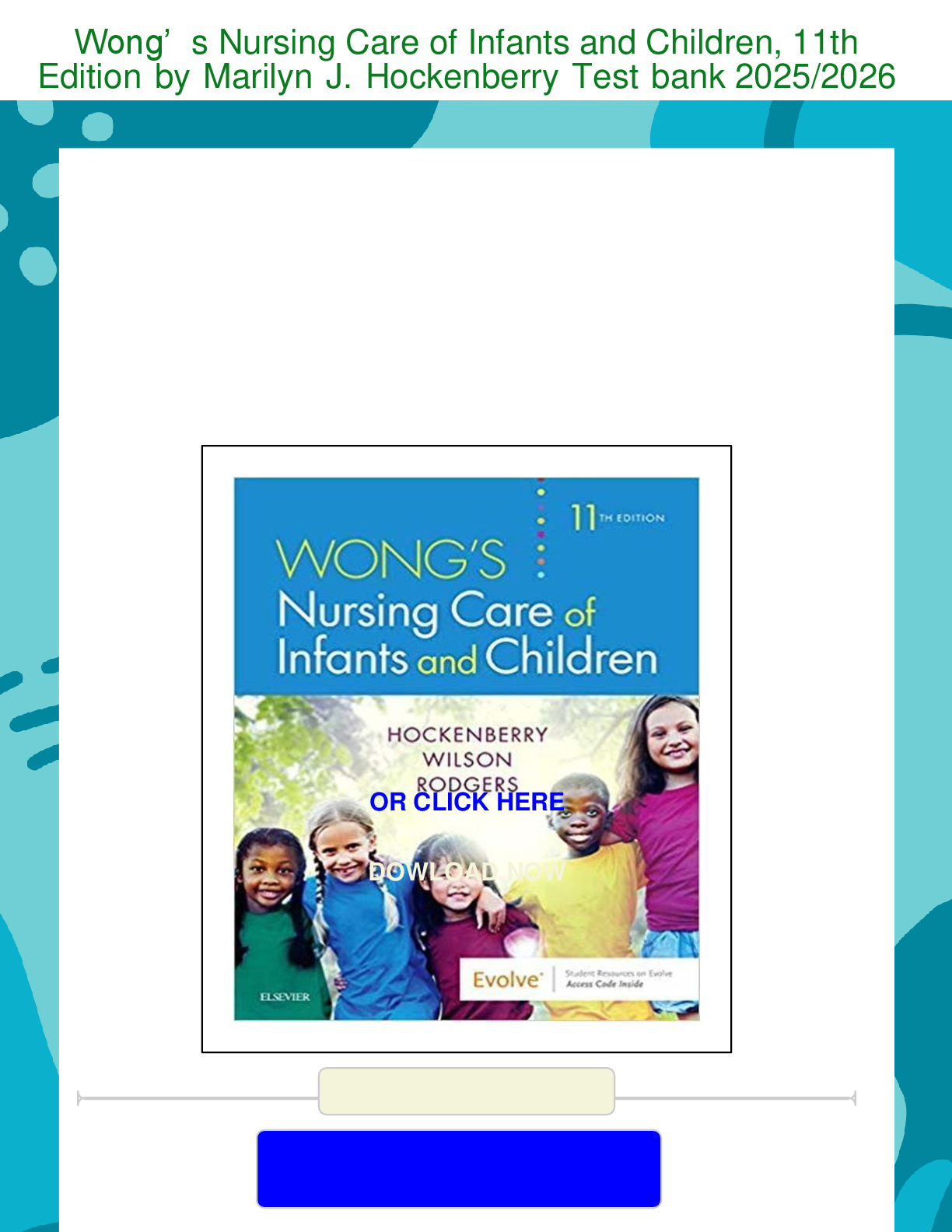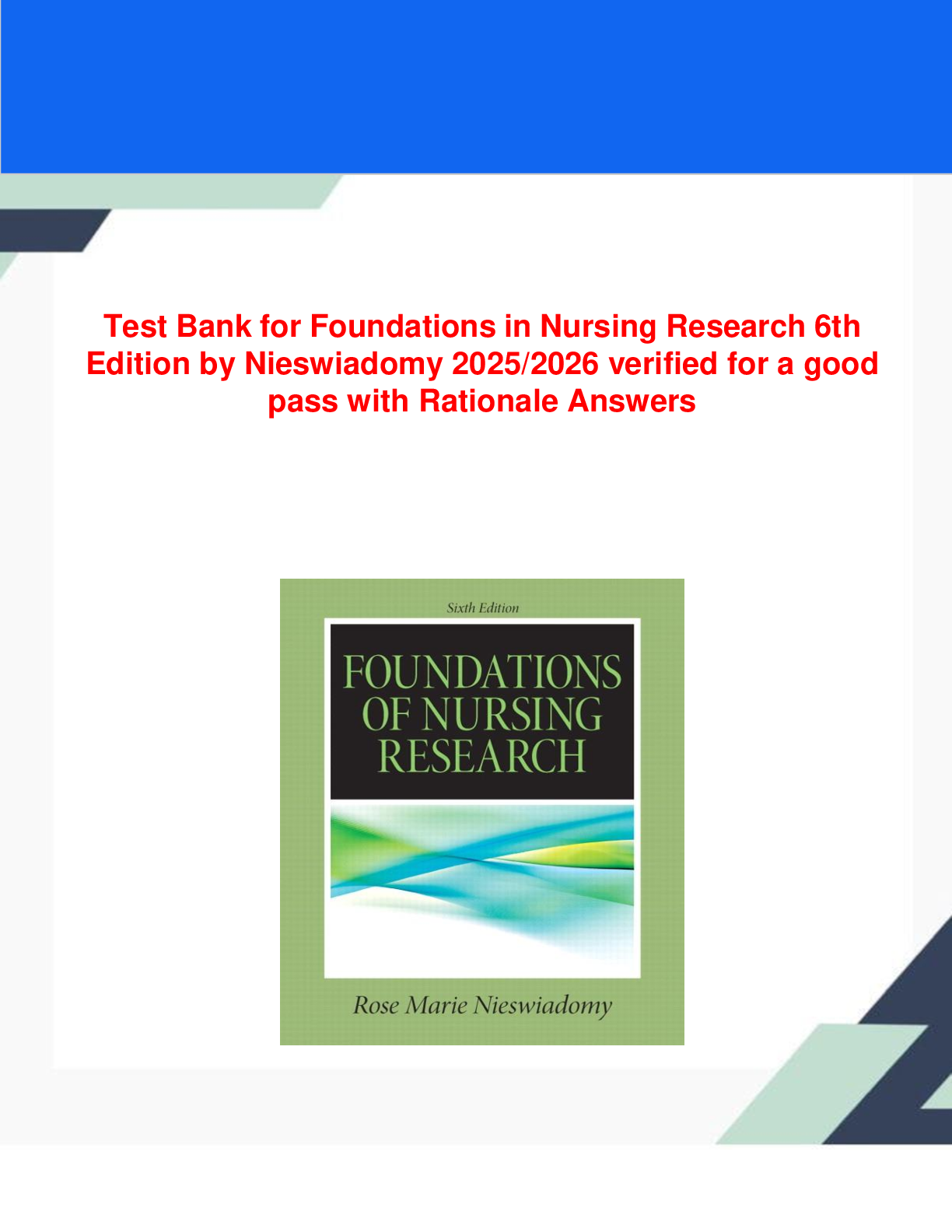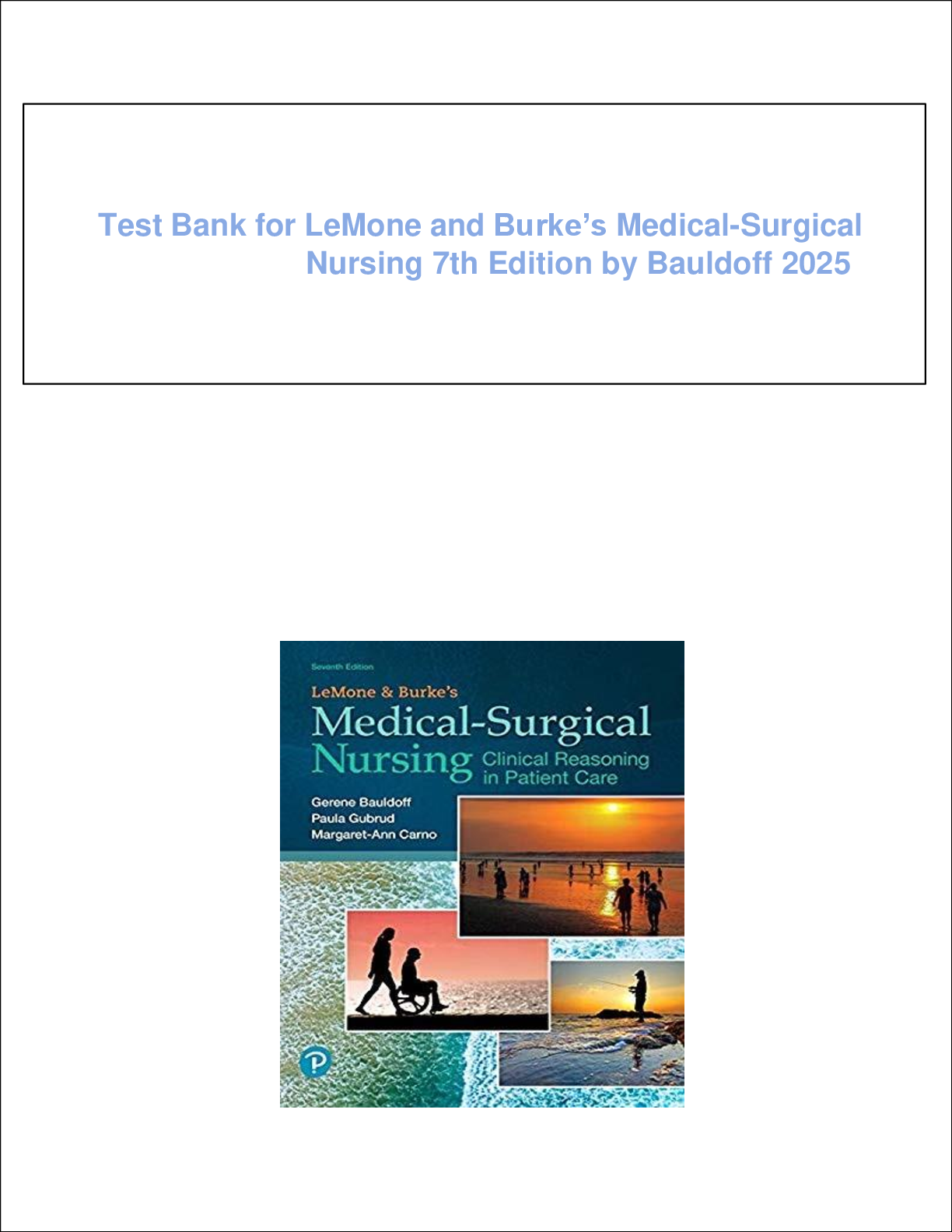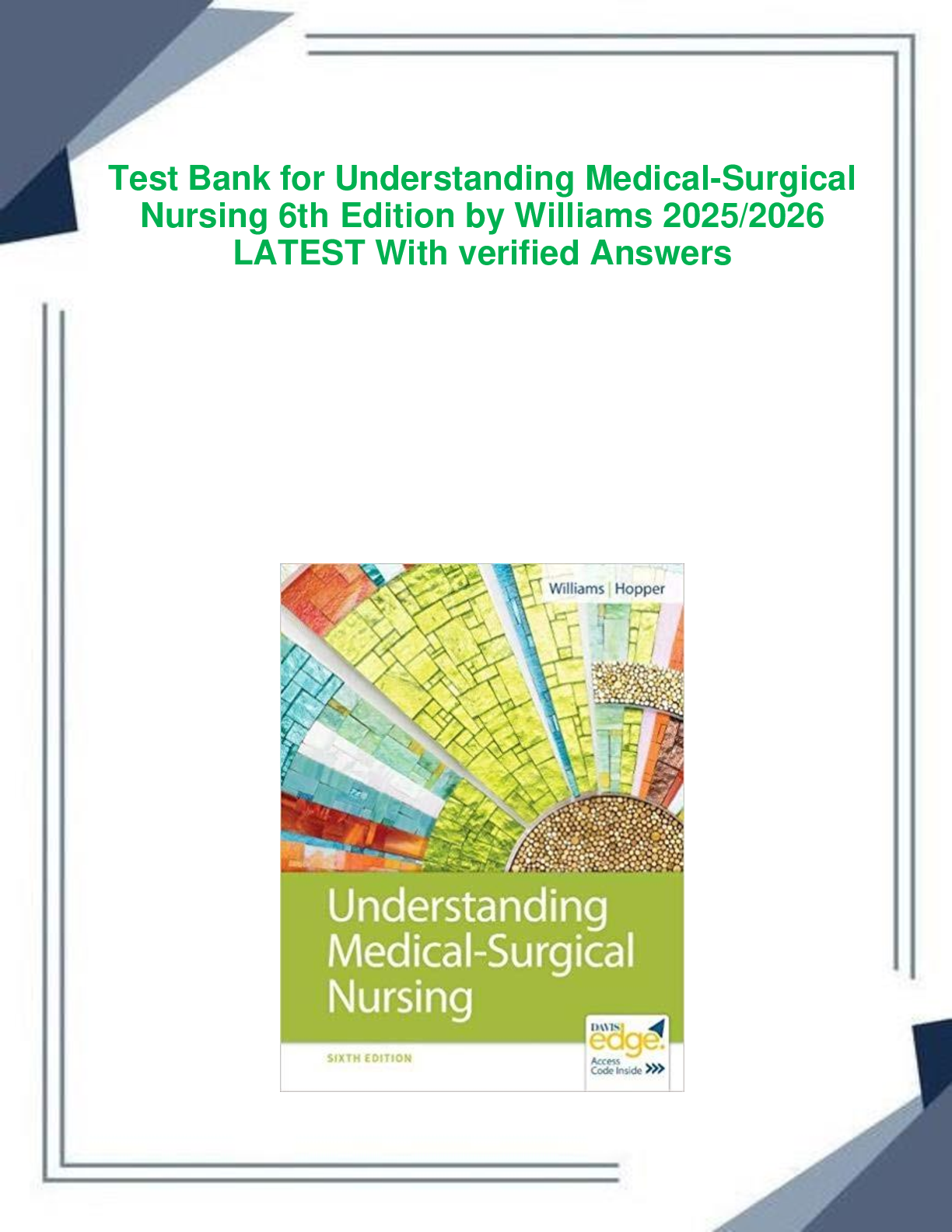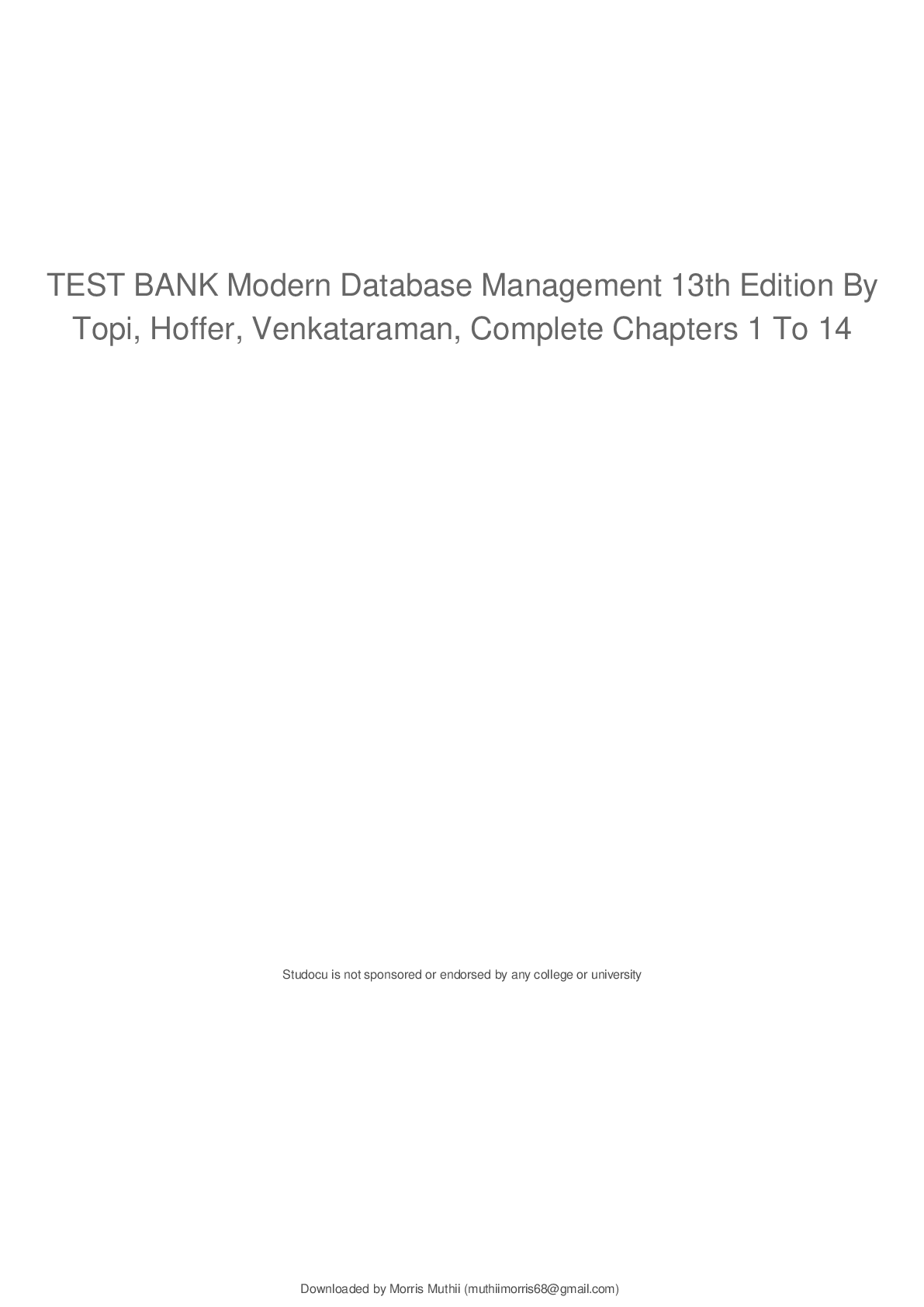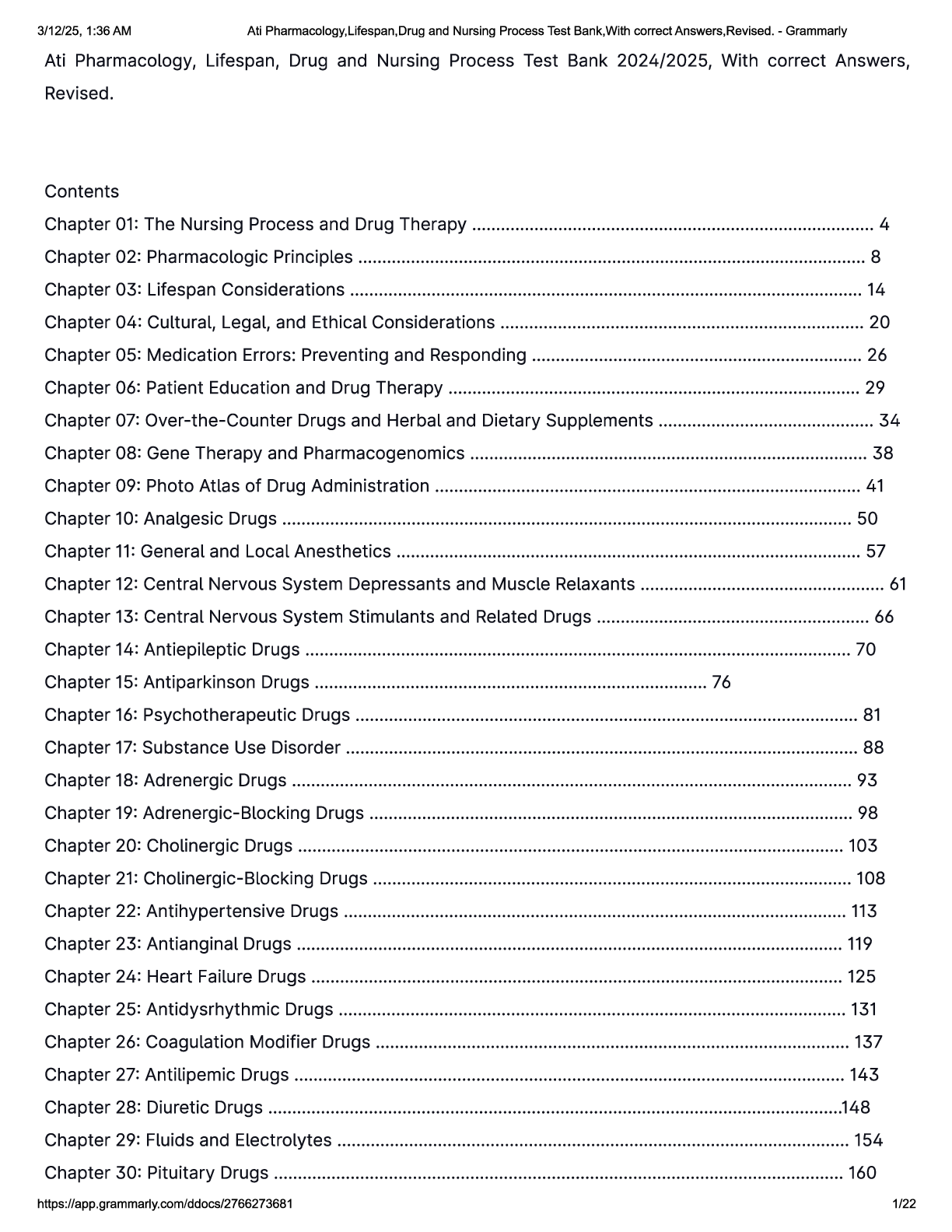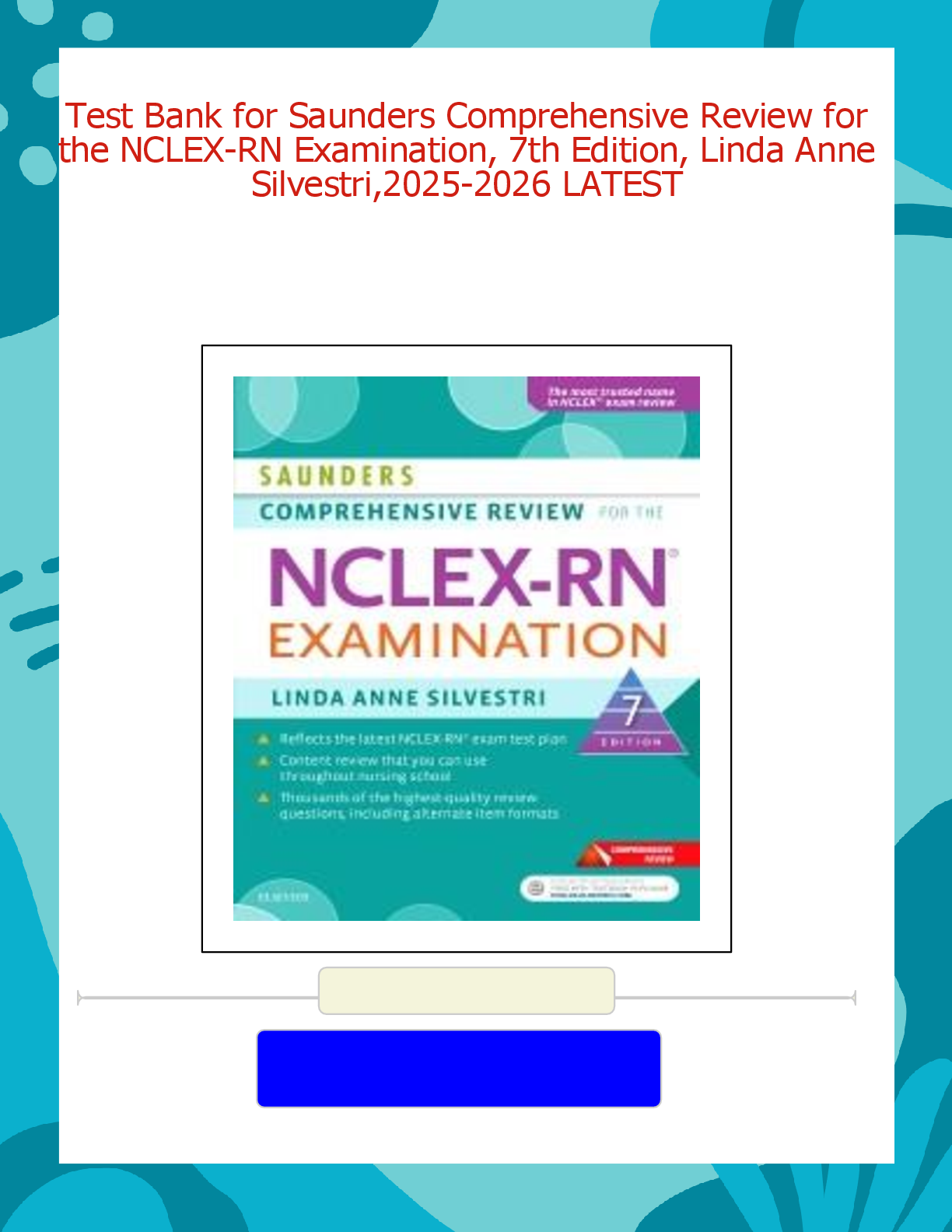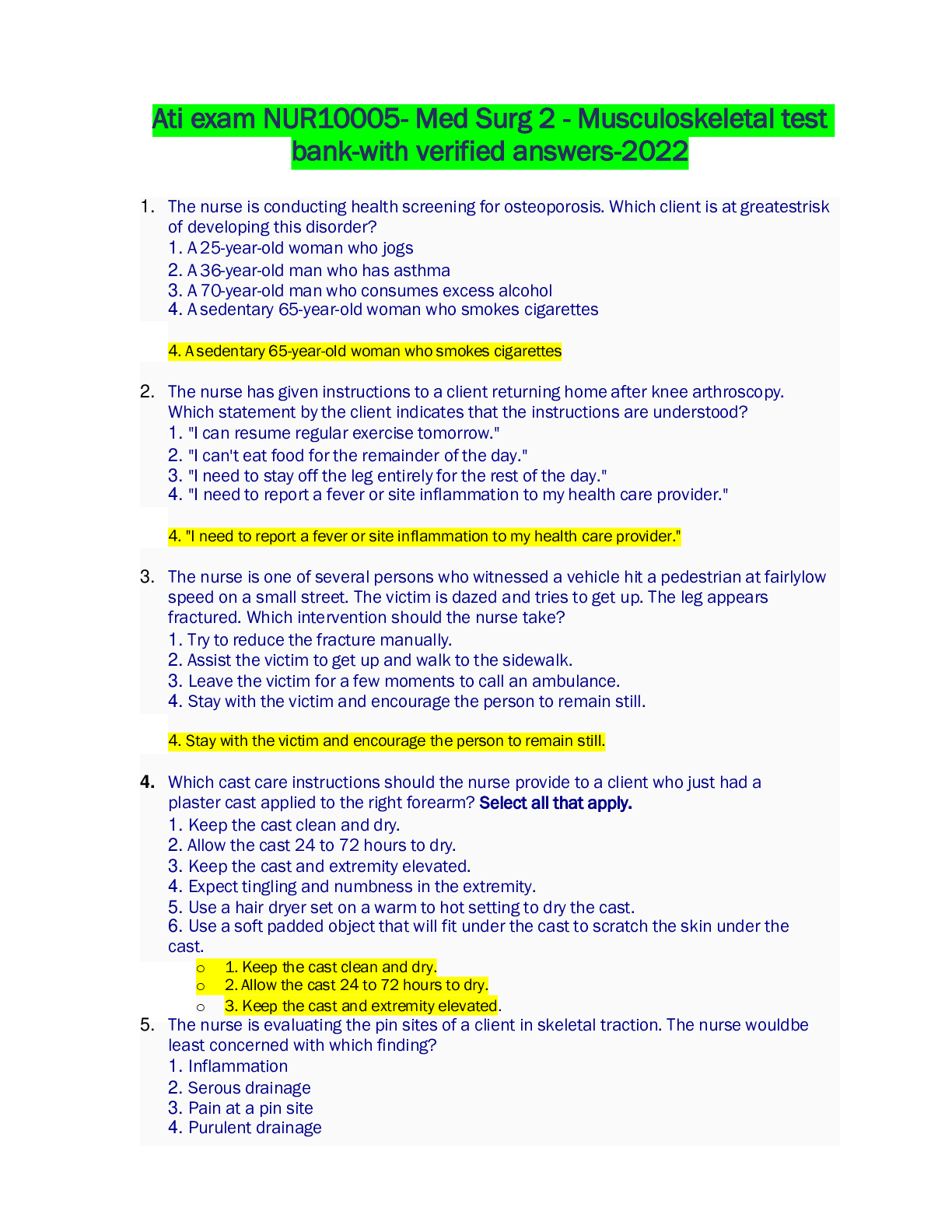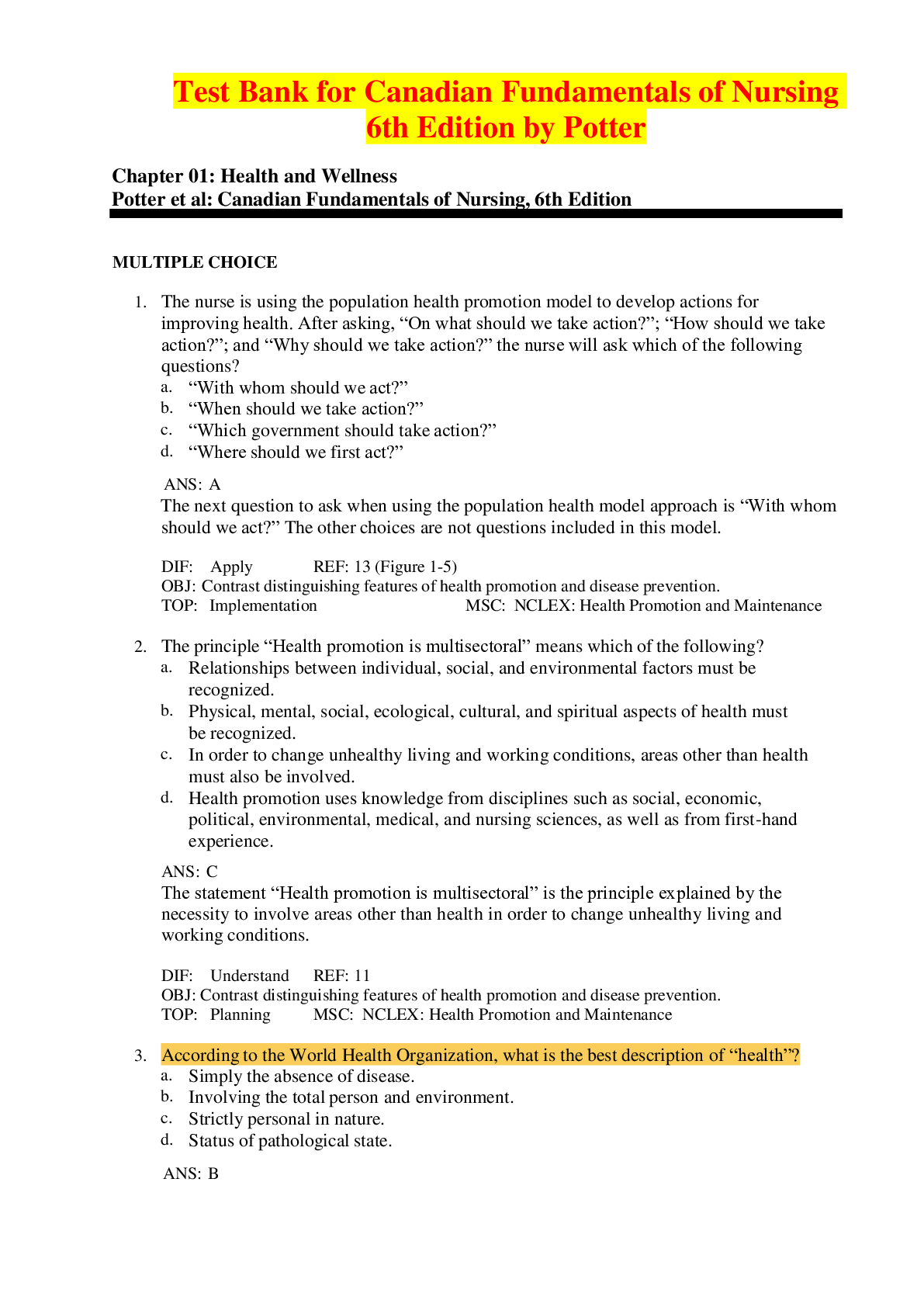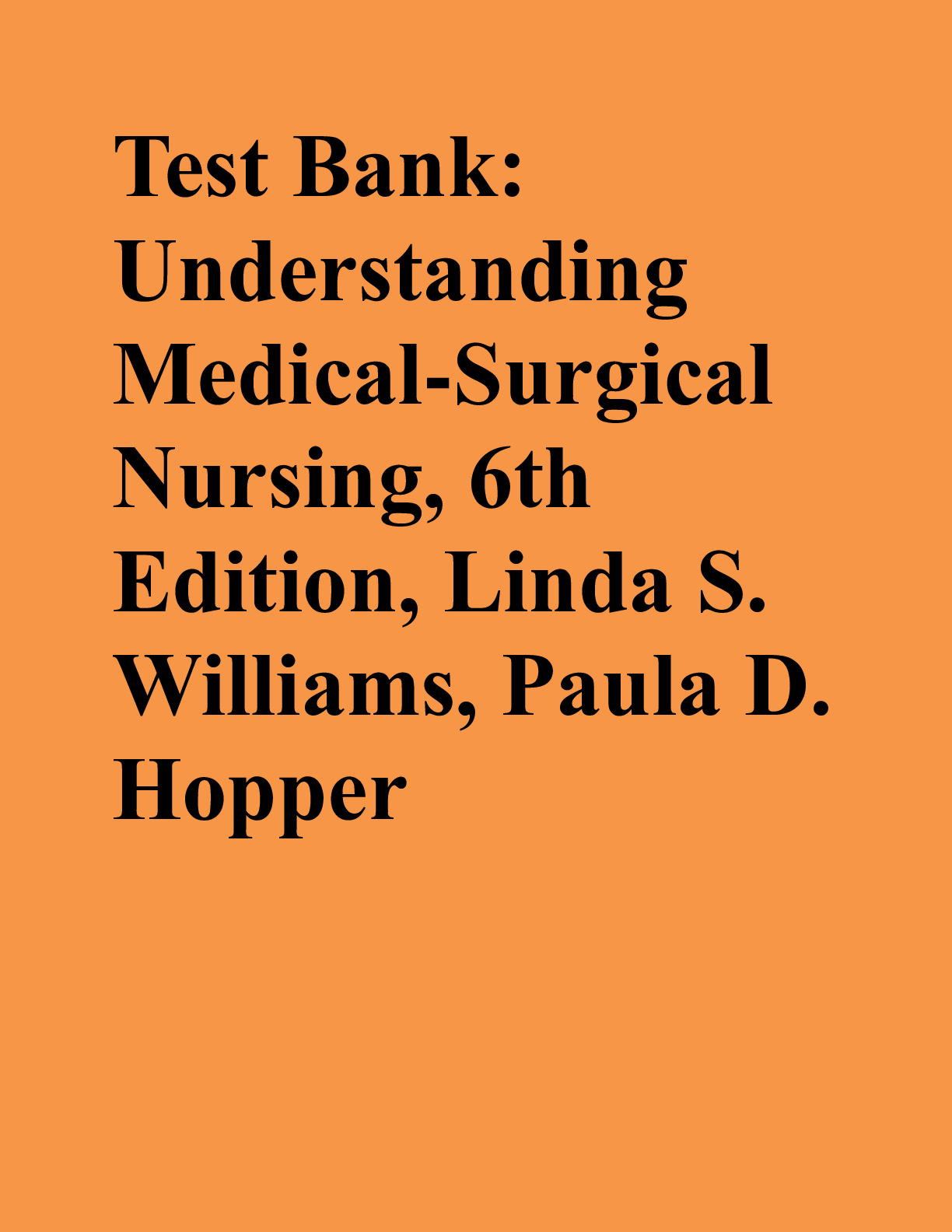*NURSING > TEST BANK > Test Bank for Understanding Medical-Surgical Nursing 6th Edition by Williams 2025/2026 LATEST With (All)
Test Bank for Understanding Medical-Surgical Nursing 6th Edition by Williams 2025/2026 LATEST With verified Answers
Document Content and Description Below
MULTIPLE CHOICE 1. The nurse working in a radiation oncology department wants to reduce the incidence of skin breakdown in patients who receive beam radiation. Which question should the nurse use ... to guide a literature search about this topic? 1. How often do patients with beam radiation experience skin breakdown? 2. Why do patients who get radiation beam therapy have skin breakdown? 3. What nursing interventions minimize the occurrence of skin breakdown in patients receiving beam radiation? 4. How does our rate of skin breakdown in patients receiving beam radiation compare to other institutions in the city? ANS: 3 Chapter: Chapter 2 Evidence-Based Practice Objective: 4. Describe the EBP process. Page: 10 Heading: Step 1: Ask the Burning Question Integrated Process: Clinical Problem-Solving Process (Nursing Process) Client Need: PHYS: Reduction of Risk Potential Cognitive Level: Application (Applying) Concept: Evidence-Based Practice Difficulty: Moderate Feedback 1 The frequency of skin breakdown and why patients develop skin breakdown does not help identify ways to prevent skin breakdown. 2 The frequency of skin breakdown and why patients develop skin breakdown does not help identify ways to prevent skin breakdown. 3 Asking a burning clinical question is the first step in the evidence-based practice (EBP) process. It is important to include related factors in the question and to focus on nursing interventions and care. In this situation, the nurse should focus on nursing care that may reduce the occurrence of skin breakdown for the specific patient population of interest. 4 Information on statistics from other organizations will not help the nurse identify ways to prevent skin breakdown. PTS: 1 CON: Evidence-Based Practice 2. A licensed practical nurse (LPN) working on the pediatric floor is interested in improving patient outcomes for children with asthma. Which clinical question would best guide the nurse’s next steps? 1. How many patients with asthma have a pet dog or cat? 2. What is the monthly admission rate of patients with asthma to the unit? 3. What patient education materials are available to address effective management of asthma in pediatric patients? 4. How has the occurrence rate of asthma in children under the age of 5 changed since the hospital instituted a no smoking policy for the hospital grounds? ANS: 3 Chapter: Chapter 2 Evidence-Based Practice Objective: 4. Describe the EBP process. Page: 11 Heading: Step 1: Ask the Burning Question Integrated Process: Clinical Problem-Solving Process (Nursing Process) Client Need: SECE: Coordinated Care Cognitive Level: Application (Applying) Concept: Evidence-Based Practice Difficulty: Moderate Feedback 1 Information about pets, admission rates of patients with asthma, and asthma occurrence since the implementation of a no smoking policy will not help improve patient outcomes for children with asthma. 2 Information about pets, admission rates of patients with asthma, an asthma occurrence since the implementation of a no smoking policy will not help improve patient outcomes for children with asthma. 3 Asking a burning clinical question is the first step in the EBP process. It is important to include related factors in the question and to focus on nursing interventions and care. For this scenario, the nurse would focus on nursing care that affects patient outcomes for the specific patient population of interest. Patient education is a critical component of nursing care. 4 Information about pets, admission rates of patients with asthma, and asthma occurrence since the implementation of a no smoking policy will not help improve patient outcomes for children with asthma. PTS: 1 CON: Evidence-Based Practice 3. The nurse is preparing to give oral care to a patient receiving tube feedings. Which approach should the nurse use to provide care that is based on EBP? 1. Use a soft toothbrush and toothpaste to brush the teeth. 2. Have the patient use swish-and-swallow Nystatin twice a day. 3. Increase oral suctioning to every 2 hours using toothette suction devices. 4. Use mouthwash and toothettes to swab the teeth and mouth three times a day. ANS: 1 Chapter: Chapter 2 Evidence-Based Practice Objective: 3. Explain how to identify nursing evidence that should be put into practice. Page: 12 Heading: Step 3: Think Critically Integrated Process: Clinical Problem-Solving Process (Nursing Process) Client Need: PHYS: Basic Care and Comfort Cognitive Level: Application (Applying) Concept: Evidence-Based Practice Difficulty: Moderate Feedback 1 Evidence-based information shows the use of toothbrushes for oral care is much more effective than foam swabs in removing plaque from the teeth. 2 Swish-and-swallow Nystatin is a medication that treats oral thrush and is not routinely used to provide oral care. 3 Oral suctioning is not an approach to provide oral care. 4 Toothettes are not an effective mechanism for providing oral care. PTS: 1 CON: Evidence-Based Practice 4. The nurse is reviewing four articles for research and notes the evidence presented in one article is weaker than the others. Which level of research is the nurse most likely reviewing? 1. Level I 2. Level II 3. Level III 4. Level IV ANS: 4 Chapter: Chapter 2 Evidence-Based Practice Objective: 3. Explain how to identify nursing evidence that should be put into practice. Page: 11 Heading: Identifying Nursing Evidence Integrated Process: Clinical Problem-Solving Process (Nursing Process) Client Need: SECE: Coordination of Care Cognitive Level: Application (Applying) Concept: Evidence-Based Practice Difficulty: Easy Feedback 1 The rating scale used to level the quality of evidence ranges form level I (strongest) to level IV (weakest). 2 The rating scale used to level the quality of evidence ranges form level I (strongest) to level IV (weakest). 3 The rating scale used to level the quality of evidence ranges form level I (strongest) to level IV (weakest). 4 The rating scale used to level the quality of evidence ranges form level I (strongest) to level IV (weakest). PTS: 1 CON: Evidence-Based Practice 5. The nurse working on an oncology unit wants to know if it is best practice to clean a central line in a circular motion or a back-and-forth motion. What action should the nurse take first? 1. Ask the physicians what they think is best. 2. Ask the patient what their preference is. 3. Develop a research question to guide a literature search. 4. Continue performing the procedure per hospital policy. ANS: 3 Chapter: Chapter 2 Evidence-Based Practice Objective: 4. Describe the EBP process. Page: 11 Heading: Step 1: Ask the Burning Question Integrated Process: Clinical Problem-Solving Process (Nursing Process) Client Need: SECE: Coordinated Care Cognitive Level: Application (Applying) Concept: Evidence-Based Practice Difficulty: Moderate Feedback 1 Physicians do not determine best practice. 2 The patient’s preference may not be reflective of what is best practice. 3 The nurse should formulate a question to guide a literature search to determine the best practice for cleaning a central line. 4 The nurse should not take no action—the current practice may not be the best practice. PTS: 1 CON: Evidence-Based Practice 6. A group of nurses conducted a pilot study about implementing a team to turn patients every hour to prevent skin breakdown. The results proved the intervention to be a success. What step should the nurses take next to implement the turn team hospital wide? 1. Educate individuals in the facility about implementing the change hospital wide. 2. Collect evidence to support implementation of a turn team. 3. Plan a pilot study to determine if implementing a turn team will reduce skin breakdown. 4. Propose the change to a policy and procedure committee. ANS: 1 Chapter: Chapter 2 Evidence-Based Practice Objective: 4. Describe the EBP process. Page: 13 Heading: Step 5: Make It Happen Integrated Process: Clinical Problem-Solving Process (Nursing Process) Client Need: PHYS: Reduction of Risk Potential Cognitive Level: Application (Applying) Concept: Evidence-Based Practice Difficulty: Moderate Feedback 1 Since turning a patient is an independent nursing intervention, a literature review has been conducted, and a pilot study has been implemented where results have been proved to be successful, the next step is to educate other nurses in the facility about how to implement the turn team. 2 A literature review has already been done. 3 A pilot study has already been conducted. 4 Since turning patients is an independent nursing intervention, it is not required to go to a committee for policy and procedure change. PTS: 1 CON: Evidence-Based Practice 7. A nursing student asks the registered nurse (RN) preceptor why EBP is important. How should the nurse respond to the student? 1. “EBP makes nursing more professional.” 2. “EBP helps ensure we can demand more pay.” 3. “EBP helps validate the difference nurses really make.” 4. “EBP guides nursing decisions to optimize effective care.” ANS: 4 Chapter: Chapter 2 Evidence-Based Practice Objective: 2. Discuss why EBP should be used. Page: 11 Heading: Reasons For Using EBP Integrated Process: Clinical Problem-Solving Process (Nursing Process) Client Need: SECE: Coordinated Care Cognitive Level: Application (Applying) Concept: Evidence-Based Practice Difficulty: Moderate Feedback 1 EBP is not used to support professionalism in nursing or as a mechanism to increase nurses’ salaries. 2 EBP is not used to support professionalism in nursing or as a mechanism to increase nurses’ salaries. 3 EBP is not used to validate the importance of nursing care. 4 Evidence-based nursing practice is much more than just evaluating research studies to determine what results to apply to nursing practice. Evidence-based nursing practice is a systematic process that utilizes current evidence to make decisions about the care of patients, including evaluation of quality and applicability of existing research, patient preferences, costs, clinical expertise, and clinical settings. PTS: 1 CON: Evidence-Based Practice 8. The nurse is reviewing a proposal for changing the type of needleless systems currently used to administer IV medications in the hospital. Which part of the proposal most effectively supports the proposed change? 1. A pilot study is planned. 2. Two cases of staff injury related to needle sticks have occurred in the past 3 years. 3. A single randomized clinical trial is cited as evidence to support the new policy. 4. The supporting evidence includes research conducted at an outpatient hematology center. ANS: 1 Chapter: Chapter 2 Evidence-Based Practice Objective: 5. List the six steps of EBP. Page: 12 Heading: Step 4: Measure Outcomes Before and After Change Integrated Process: Clinical Problem-Solving Process (Nursing Process) Client Need: SECE: Coordinated Care Cognitive Level: Application (Applying) Concept: Evidence-Based Practice Difficulty: Difficult Feedback 1 A small pilot study is typically done before an institute-wide change is made. 2 This would not be a statistically significant number to support the need for change. 3 More evidence or evidence of a higher level would better support the proposed change. 4 It is important to consider the context in which the evidence will be used, and research involving a population similar to that of the nurse’s institution is helpful. PTS: 1 CON: Evidence-Based Practice 9. The nurse is planning a Quality and Safety Education for Nurses (QSEN) project to focus on informatics. Which would the nurse include in this project? 1. Collecting data on repeat admissions 2. Implementing a medication barcode system 3. Collaborating with a pharmacist about medication reconciliation 4. Including the patient in a care plan meeting ANS: 2 Chapter: Chapter 2 Evidence-Based Practice Objective: 8. Describe how the Quality and Safety Education for Nurses (QSEN) project can promote safe patient care. Page: 12 Heading: Quality and Safety Education for Nurses Project Integrated Process: Clinical Problem-Solving Process (Nursing Process) Client Need: SECE: Coordination of Care Cognitive Level: Application (Applying) Concept: Evidence-Based Practice Difficulty: Moderate Feedback 1 Collecting data on repeat admissions is an example of quality improvement. 2 Implementing a medication barcode system is an example of informatics. 3 Collaborating with a pharmacist about medication reconciliation is an example of teamwork and collaboration. 4 Including a patient in a care plan meeting demonstrates patient-centered care. PTS: 1 CON: Evidence-Based Practice 10. The nurse is teaching a group of students about implementing EBP to control pain. Which statement best describes understanding of evidence? 1. “I saw a commercial for pain medication that works well.” 2. “The patient has chronic pain and will need more medication.” 3. “We could give this patient Morphine every 4 hours. It works for the other patient.” 4. “There are studies that prove nonpharmacological methods can relieve pain.” ANS: 4 Chapter: Chapter 2 Evidence-Based Practice Objective: 1. Define evidence-based practice (EBP) and evidence-informed practice. Page: 12 Heading: Reasons For Using EBP Integrated Process: Clinical Problem-Solving Process (Nursing Process) Client Need: SECE: Coordinated Care Cognitive Level: Application (Applying) Concept: Evidence-Based Practice Difficulty: Moderate Feedback 1 Watching a commercial does not demonstrate an understanding of evidence. 2 Not all patients who experience chronic pain need more medication; this statement does not demonstrate an understanding of evidence. 3 Just because a drug regimen works for one patient does not mean it will work for another. This statement does not demonstrate evidence. 4 Basing care on studies demonstrates an understanding of evidence. PTS: 1 CON: Evidence-Based Practice 11. A licensed practical nurse/licensed vocational nurse (LPN/LVN) is preparing to insert an indwelling urinary catheter. The policy states to test the balloon before inserting the catheter, although evidence supports not testing the balloon. Which action should the nurse take? 1. Continue to test the balloon per hospital policy. 2. Refuse to insert the catheter until policy is changed. 3. Conduct a literature search and present the literature to the policy committee. 4. Begin the practice of not testing the balloon when inserting urinary catheters. ANS: 3 Chapter: Chapter 2 Evidence-Based Practice Objective: 4. Describe the EBP process. Page: 12 Heading: Step 2: Search for and Collect the Most Relevant and Best Evidence Available [Show More]
Last updated: 2 months ago
Preview 1 out of 47 pages

Loading document previews ...
Buy this document to get the full access instantly
Instant Download Access after purchase
Buy NowInstant download
We Accept:

Reviews( 0 )
$18.50
Can't find what you want? Try our AI powered Search
Document information
Connected school, study & course
About the document
Uploaded On
Mar 31, 2025
Number of pages
47
Written in
Additional information
This document has been written for:
Uploaded
Mar 31, 2025
Downloads
0
Views
13
